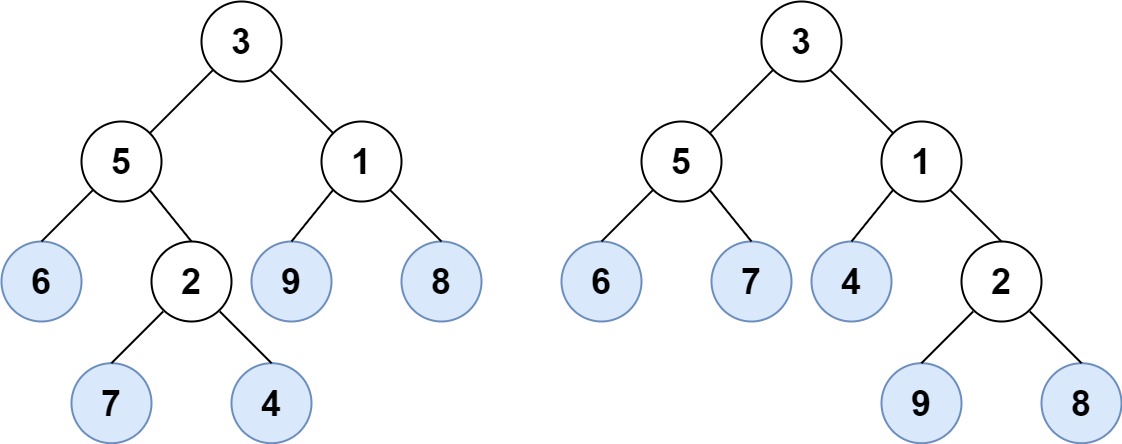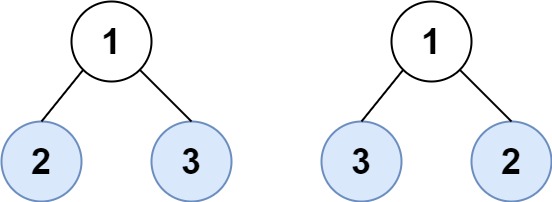872.Leaf-Similar Trees
===
###### tags: `Easy`,`Tree`,`Binary Tree`,`DFS`
[872. Leaf-Similar Trees](https://leetcode.com/problems/leaf-similar-trees/)
### 題目描述
Consider all the leaves of a binary tree, from left to right order, the values of those leaves form a **leaf value sequence**.

For example, in the given tree above, the leaf value sequence is `(6, 7, 4, 9, 8)`.
Two binary trees are considered *leaf-similar* if their leaf value sequence is the same.
Return `true` if and only if the two given trees with head nodes `root1` and `root2` are leaf-similar.
### 範例
**Example 1:**

```
Input: root1 = [3,5,1,6,2,9,8,null,null,7,4], root2 = [3,5,1,6,7,4,2,null,null,null,null,null,null,9,8]
Output: true
```
**Example 2:**

```
Input: root = [5,1,4,null,null,3,6]
Output: false
Explanation: The root node's value is 5 but its right child's value is 4.
```
**Constraints**:
* The number of nodes in each tree will be in the range `[1, 200]`.
* Both of the given trees will have values in the range `[0, 200]`.
### 解答
#### C#
```csharp=
public class Solution {
public bool LeafSimilar(TreeNode root1, TreeNode root2) {
var list1 = PreorderLeaves(root1).GetEnumerator();
var list2 = PreorderLeaves(root2).GetEnumerator();
while (list1.MoveNext()) {
if (!list2.MoveNext() ||
list1.Current != list2.Current) {
return false;
}
}
if (list2.MoveNext()) return false;
return true;
}
private IEnumerable<int> PreorderLeaves(TreeNode root) {
var stack = new Stack<TreeNode>();
stack.Push(root);
while (stack.Count > 0) {
var node = stack.Pop();
if (node.left == null && node.right == null) {
yield return node.val;
}
if (node.right != null) {
stack.Push(node.right);
}
if (node.left != null) {
stack.Push(node.left);
}
}
}
```
遞迴版本
```csharp=
public class Solution {
public bool LeafSimilar(TreeNode root1, TreeNode root2) {
return Dfs(root1).SequenceEqual(Dfs(root2));
}
private IEnumerable<int> Dfs(TreeNode node) {
if (node.left == null && node.right == null) {
yield return node.val;
}
if (node.left != null) {
foreach (int val in Dfs(node.left)) {
yield return val;
}
}
if (node.right != null) {
foreach (int val in Dfs(node.right)) {
yield return val;
}
}
}
}
```
>[name=Jim][time= Dec 8, 2022]
#### Python
```python=
# Definition for a binary tree node.
# class TreeNode:
# def __init__(self, val=0, left=None, right=None):
# self.val = val
# self.left = left
# self.right = right
class Solution:
def leafSimilar(self, root1: Optional[TreeNode], root2: Optional[TreeNode]) -> bool:
def findLeaf(root):
res, l_res, r_res = [], [], []
if not root.left and not root.right:
res.append(root.val)
if root.left:
l_res = findLeaf(root.left)
if root.right:
r_res = findLeaf(root.right)
return res + l_res + r_res
return findLeaf(root1) == findLeaf(root2)
```
>[name=Kobe][time= Dec 8, 2022]
```python=
class Solution:
def leafSimilar(self, root1: Optional[TreeNode], root2: Optional[TreeNode]) -> bool:
def dfs(root):
if root:
if not root.left and not root.right:
yield root.val
for v in dfs(root.left):
yield v
for v in dfs(root.right):
yield v
return list(dfs(root1)) == list(dfs(root2))
```
> [name=Yen-Chi Chen][time=Thu, Dec 8, 2022]
#### C++
```cpp=
class Solution {
public:
void dfs(TreeNode* root, vector<int>& leaves) {
if (!root) return;
if (!root->left && !root->right) leaves.push_back(root->val);
dfs(root->left, leaves);
dfs(root->right, leaves);
}
bool leafSimilar(TreeNode* root1, TreeNode* root2) {
vector<int> leaves1, leaves2;
dfs(root1, leaves1);
dfs(root2, leaves2);
return leaves1 == leaves2;
}
};
```
> [name=Yen-Chi Chen][time=Thu, Dec 8, 2022]
#### Javascript
```javascript=
function leafSimilar(root1, root2) {
return findLeaf(root1).toString() === findLeaf(root2).toString();
}
function findLeaf(root) {
const leaf = [];
if (root === null) return leaf;
if (root.left === null && root.right === null) {
leaf.push(root.val);
}
leaf.push(...findLeaf(root.left));
leaf.push(...findLeaf(root.right));
return leaf;
}
```
>[name=Marsgoat][time= Dec 8, 2022]
### Reference
[回到題目列表](https://hackmd.io/@Marsgoat/leetcode_every_day)